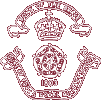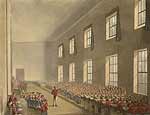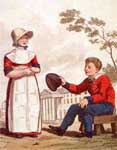


 |
 |
|
 |
||
| Navigation links at the bottom of this page | ||||||
| History of the R M A (1803 - 1892) The Charity of Mars |
||||||
The armed conflict between Britain and its allies with Revolutionary France (1793 to 1815), ending with the Battle of Waterloo on 18 June 1815, was known as 'the Great War'. During the more than twenty years of almost continuous warfare, one million men and boys (1) from the British Isles bore arms in the armed forces, the Army or Royal Navy. At the beginning of the nineteenth century, the population of the British Isles was about 14 million. This meant that over seven per cent of the population had served in the conflict. By the time the war ended over 315,000 of those who took part had been killed. In 1801, Frederick, Duke of York, the second son of George III and Commander-in-Chief of the British Army for most of the Great War, founded the Royal Military Asylum (2) by royal warrant. In his day, York was the butt of a lampoon that became so well known it take its place in the annals of nursery rhymes as 'The Grand old Duke of York, he had ten thousand men; he marched them to the top of the hill and march down again. (3) Funded by the Army, the RMA became a home to children of fallen rank and file soldiers. At the height of the war, the RMA was home to 1,500 military orphans, 1,000 boys and 500 girls. The phenomenon of the Asylum that that began in 1801 (4) is best understood as a frontal assault on the arrogance, ignorance, brutality and, all too often, the savageness of the officers towards the rank and file soldiers. The disregard and disdain of the officers for the common soldier was widespread and existed at all levels of command. For example, at the regimental level, there is the case of the 48th Foot. (5) This regiment’s commanding officer, Lt. Colonel Donnelly, routinely awarded private soldiers and NCOs a thousand lashes of the cat o'nine tails for the most minor offences during the battlion’s service at Gibraltar (1779 to 1783). Punishment was delivered at the halberds (6) by relays of drummers. I t was from this period that the 48th Foot’s service that it got its nickname 'The Steelbacks'. At the brigade level, General Craufurd, the coarse and brutish commander of the Light Brigade, held a drumhead court for two alleged deserters on the Brigade's retreat to the port of Vigo and awarded 300 lashes on the spot to a third Rifleman, Dan Howens, for speaking his mind in his hearing (7). At the highest level of field command, the attitude of the officers in the early 1800s is epitomised in Wellington's casual observation that the soldiers of his Peninsular Army were the 'scum of the earth'. Wellington was no friend of the common soldier. This place went to the much-maligned York, who has always been known as 'the soldier's friend' (8). The people responsible for the harsh discipline the ordinary soldier endured during the period of the Great War, including Wellington's Army during the Peninsular Campaign, deserve the strictest censure for their actions. On the other side of the scale, there were those who by their words and deeds worked diligently to ameliorate the suffering, misery and distress of the soldier. Full recognition should be accorded to the men and women who gave comfort to the common soldier and his dependants during this harsh period in the history of British arms. It was through the efforts of such people, but principally through the Noble Duke of York, that resulted in the creation of the Royal Military Asylum. The Institution was modelled on the Royal Hibernian Military School (1765 - 1924), Dublin, that had been founded and funded by The Hibernian Society for the destitute families of rank and file soldiers of the Irish Establishment. (9) Officers, politicians, men and women connected with the RMA were for the most part devoted public servants, but not invariably upstanding, honourable, ethical and honest. Most of course were incorruptible and stalwart supporters of the system, but some were incorrigible rogues and scoundrels to which the records bear eloquent testimony. To govern the new Asylum, the Commander-in-Chief formed a Board of Commissioners from among his most senior generals at the Horse Guards (10), officers who had been under his command when campaigning against the revolutionary army of France in the Low Countries. The RMA was intended to replace the dependence of military families on regimental depots and the charity of the officers. Alternatively, destitute families of soldiers had to rely on the workhouse system, which meant that families first had to travel from the regimental depot to the parish in which the father had been born. This could mean a long and arduous journey for which the Commanding Officer of the regiment in question had to provide a signed pass of safe conduct through parishes along the way to avoid being charged with vagrancy. The design of the main building that formed the centerpiece of the Asylum with its Doric columns was design similar that used for many impressive public buildings of the period. |
||||||
 |
||||||
| The Royal Military Asylum, Chelsea (1803-1892) | ||||||
| From its inception, the Asylum provided the country with the first large scale system of education of working class children. For this purpose, the monitorial system of education was used, first introduced by Joseph Lancaster (1778-1838), a Quaker. It involved one or more teachers who gave lessons to monitors who, in turn, taught up to 20 of their fellow students. The Asylum children were taught reading, writing and the four rules of arithmetic. Within a few years, Lancaster's system was replaced by the almost identical 'Madras' system developed by Dr. Andrew Bell (11), an Anglican minister at an orphanage in Madras, India. Bell so impressed the Duke of York that his system of monitorial instruction was introduced not only at the RMA but throughout all regimental schools of the British Army. It is, however, fairly certain that Dr. Bell and the RMA Commissioners being of the Established Church strongly influenced the outcome of the battle for dominance of the Madras System. | ||||||
 |
||||||
| A monitorial teaching session in progress using the Lancaster System |
||||||
Within a short time, boy monitors of 13 and 14 years of age from the Asylum were sent to India, the West Indies, the Iberian Peninsula, Canada and distant stations of the empire to introduce the monitorial system of education to regimental schools. The passages of two boys shipped to Canada became the subject of a dispute as to who would bear the £5 cost of the return passage. One of the most remarkable features of the Army's co-educational RMA on so large a scale was, for the time, an exceptional development. Considering the Army's total lack of experience in caring for children, the attention given to soldier's daughters as well as sons was unprecedented. An all-female staff supervised the girls. The most interesting and indeed sad occurrence in the short life of the 'Female Establishment' was its demise and the eventual denial of entry to girls. Interestingly, the decision to deny entry to the daughters of soldiers came about at the instigation of, and on fallacious evidence provided by the aging matron (12) Even so, in retrospect, the exclusion of female students was a deplorable and ungracious decision by the Commissioners (13) |
||||||
 |
||||||
| Miss Corporal and a fellow student | ||||||
The confinement of children in the restricted space of the RMA accommodation led to difficulties during outbreaks of cholera, diphtheria, chickenpox and like infectious and contagious outbreaks that occurred from time to time (14) They posed a constant threat to the crowded conditions of the Asylum. None was more difficult and mysterious than an outbreak in 1809 of what came to be known as 'ophthalmia'. In the early years of the nineteenth century, viral infection and the existence of bacteria was unknown. The discoveries of Pasteur and Lister were fifty years away. For two years, the outbreak raged and defied the leading medical minds of London to find a solution. Children and the nurses caring for them went partially and, in some cases, permanently blind. Children of the Asylum (circa 1807) The Asylum's lowly surgeon, Surgeon McGregor, provided the solution that put an abrupt end to outbreak when he persuaded the Commissioners to provide each child with his or her own towel at a total cost of £100. (15) McGregor himself had no idea why his solution worked. He only knew that it was the last possible reason for the continuing affliction. The disease posed a medical mystery that was only recently satisfactorily explained by the joint effort of microbiology units in three universities: the Boston Research Clinic, an Oxford research unit and the Research Clinic of Trinity, Dublin. (16) The consensus is that the epidemic was in fact an occurrence of trachoma, a sub-Sahara disease that does not occur in temperate northern climates. This contradiction is explained by the fact that immediately before the outbreak, twenty-four children from units stationed in Malta and twelve children from Gibraltar were admitted to the Asylum, seven only after they had been cured of the 'itch', which was probably scabies. During the early years of the Institution and well into the nineteenth Century, children leaving the Asylum were provided with indentured apprenticeships in all trades and callings. This was a remarkably generous service the Asylum authorities provided. The experience of the cotton weaver apprentices, both boys and girls, indentured to cotton weavers and journeymen in Lancashire in the 1820s and 30s, however, led to a major enquiry by the Adjutant General Department (17) The children were being used and abused to the point of suffering physical harm. One child died from his injuries; another was maimed for life. In the face of the industrial revolution and creation of cotton spinning factories, independent cotton weavers were reduced to weaving fustian cloth. Unable to attract apprentices from local workhouses, the journeymen conspired to obtain apprentices from the RMA (18) One of the most contentious issues in the life of the Asylum was Catholic emancipation stemming from the Act of Union with Ireland in 1801. The Catholic Emancipation Act of 1829 was a natural development of British politics, which Wellington (19) succeeded in getting through Parliament with the support of Peel and Pitt. The Act was passed in the face of stiff opposition from the Monarchy, the Army and the 'Established Church'. On the strength of the Act, the long-suppressed Roman Catholics began flexing their muscles in numerous ways. The correspondence of the RMA provides a rich source of data with which to trace the development of the Catholic struggle with the Established Church at the Institutional level (20) Last but not least in this brief account of the history of the Royal Military Asylum is the development of Army education, which was many years ahead of universal education in society at large. (21) In the mid-1840s, to create a 'Normal School' (22) for training sergeant schoolteachers, the Board of Commissioners transformed the Asylum into a 'Normal School' and , for training purposes, a 'Model School'. To accomplish this end, the student population was considerably reduced, civilian masters were hired, and students engaged to learn the trade(23) of teaching, eventually to become schoolmaster sergeants. The introduction of civilians into the Institution's hierarchy led, inevitably, to a clash between the new civilian staff with the established military personnel, which was only to be expected. In 1892, the RMA was renamed The Duke of York's Royal Military School and, in 1909, moved to new premises constructed on the Downs of Dover, Kent. In the late 1980s, the daughters of soldiers were again accepted for entry to the School in equal numbers to boys. |
||||||
|
Footnotes
1. There were an estimated 4,000 boys between the ages of 10 and 17, all armies, present at the Battle of Waterloo. James Wade, a drummer in the 9th Foot (The Norfolk Regiment) was age 7 on his enlistment and present at the Battle of Bucasso. At age 28, after 21 years of service, he applied for a medical discharge due to wounds received in battle. Back to 1 |
||||||
| ||||||||||
|
© A. W. Cockerill 2011 Site Map Contact me | ||||||||||